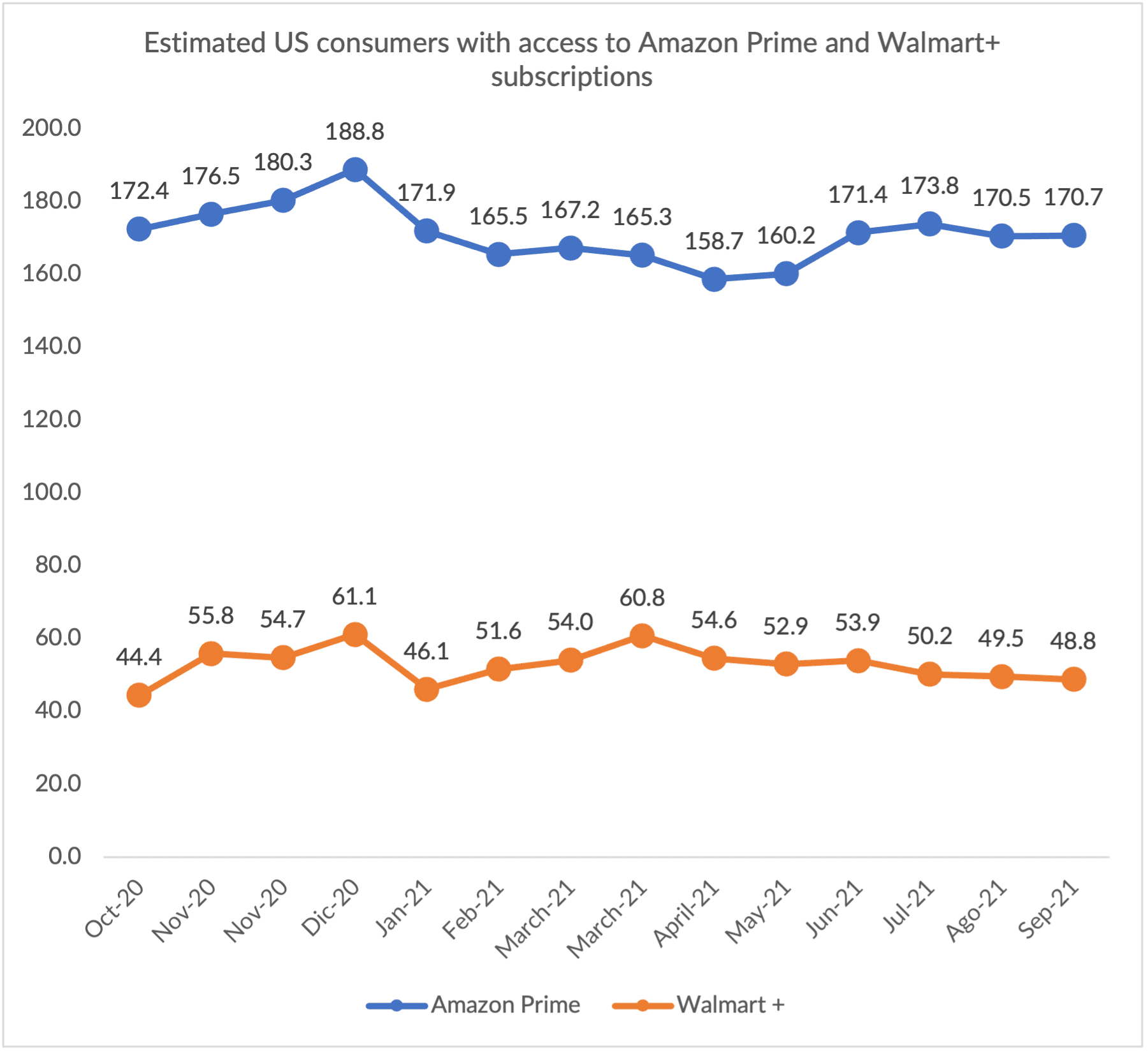AMZN vs WMT Weekly: Amazon Earnings Report to Provide Check-in on Connected Consumer

Amazon is set to report its third-quarter earnings on Thursday (Oct. 28), giving retail industry watchers insight into not only the company itself but eCommerce more broadly. After all, the Seattle-based tech company holds a 50% share of all digital sales made, according to PYMNTS data.
The past several months have been Andy Jassy’s first full quarter as CEO after founder Jeff Bezos transitioned to executive chair of Amazon, and the company has rolled out a series of innovations meant to capture more of consumers’ spending, including new Alexa-powered devices and an expansion of its Halo fitness platform.
Read more: Amazon Leans on Alexa to Connect With ‘All Aspects of Consumers’ Lives’
In the second quarter, Amazon reported a rare quarterly sales miss despite an early Prime Day sales event during which consumers spent a record $11 billion. Chief Financial Officer Brian Olsavsky attributed the decelerating sales to moderated spending from Prime members and consumers’ increased mobility as vaccination rates rose.
Related: Amazon Sees Decelerating Sales As Post-Lockdown Life Resumes
But over the past few months, consumers have heard a steady drumbeat of “start your holiday shopping early” as retailers highlight supply chain issues they say are forcing inventory levels lower. Many students also returned to the classroom this year, boosting back-to-school spending on apparel and books — two categories that Amazon does well in, PYMNTS data show.
A Holiday Gift for Walmart+
Walmart, meanwhile, doesn’t report its quarterly earnings until mid-November, and has been focused on bringing in customers to its stores and website this holiday season as it tries to hold off Amazon’s inevitable usurping of its title as top U.S. retailer.
This week, the Arkansas-based box store chain said it would be bringing back its “Black Friday Deals for Days” promotion, spreading discounts across three sales events throughout November as it did last year. New this year, though, is a benefit for paying Walmart+ subscribers: even earlier access to deals.
See: Walmart Expands Delivery Options Ahead of Holidays
Walmart has been slow to add new features to its subscription service, seen by many as a response to Amazon Prime, offering free next-day and two-day shipping in addition to discounts on prescription drugs and fuel prices. Many of these benefits are also provided by Prime, though, which also include access to Prime Video, Amazon Music Prime, apparel try-on service Prime Wardrobe, and unlimited photo storage.
PYMNTS data show that just under 49 million, or about 19%, of U.S. consumers have access to Walmart+, compared to the nearly 171 million, or 66%, of consumers who have access to Amazon Prime. The proprietary data are based on balanced samples of 2,200 U.S. consumers between October 2020 and September 2021.

Related: Walmart+ Marks 1st Anniversary with Slow Subscriber Growth, Unfazed Executives
Walmart CEO Doug McMillon said last month that he’s more focused on the quality of a consumer’s experience with Walmart+ than the subscriber count. The top priority, he said, is expanding Walmart’s capacity to fulfill more online grocery orders; grocery accounts for about 56% of Walmart’s total sales and is the key driver of many Walmart+ signups.
“We don’t have all the capacity that we need,” McMillon said at Goldman Sachs’ Annual Retailing Conference. “So the worst thing we could do is to really aggressively market this, get a bunch of members that are disappointed because they can’t get a slot or they don’t get the right in-stock level or some other problem happens.”
Fulfilling Food and Beverage
Walmart also this week announced the details of its next automated grocery distribution center, months after saying it wants to automate more than half of its regional distribution centers. The more than 720,000-square-foot distribution center is set to open in Spartanburg County, South Carolina, in 2024, with the capacity to fulfill twice as many orders as a traditional facility.
PYMNTS’ “Bring-It-to-Me Economy” research, conducted in collaboration with Carat from Fiserv, indicates that 46% of consumers are buying more groceries online than before March 2020; separate research, conducted with ACI Worldwide, found that 76% of consumers shop for food online because it’s easier and more convenient than shopping in-store, while 57% do so because it’s faster.
Read more: Grocers Aim to Escape eCommerce Labor Bind With Automated Fulfillment
Food and beverage accounts for just over 9% of the average household’s annual retail spend, PYMNTS data show, and it’s a category where Walmart still retains the lead over competitors, particularly Amazon. In 2020, Walmart held approximately 19% of the grocery market, a share that has held consistent for years, according to PYMNTS data. Amazon, meanwhile, has just under 2% of the grocery market, a figure relatively unchanged since its 2017 acquisition of Whole Foods.

Source: PYMNTS data
Related: Amazon’s Food Fight Fails to Minimize Walmart’s 10-to-1 Lead
Amazon in recent months has been doing slow, furtive expansion of its Amazon Fresh grocery locations while providing little insight into the long-term vision of the brand. Earlier this month, PYMNTS reported that the eCommerce giant had received approval for two new potential Amazon Fresh locations, in Braintree, Massachusetts, and Eden Prairie, Minnesota. Amazon did not confirm whether the locations were indeed grocery stores, but the architect, NORR, has connections to previous Amazon Fresh projects.
Read more: Amazon’s Grocery Footprint Grows with Amazon Fresh Expansion
Efforts to expand Amazon’s grocery reach, even during a pandemic that forced many to start ordering essentials online, have not led to growth of its category share, though, with the eCommerce company holding just 1.9% of food and beverage spend in the second quarter. Walmart, on the other hand, has seen its share of grocery spending fall slightly from a fourth-quarter high of over 20%, though it remains within the same range the box store has been accustomed to for several years.

Source: PYMNTS data
